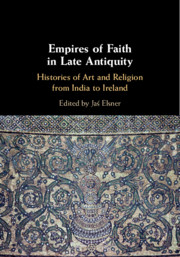Book contents
- Empires of Faith in Late Antiquity
- Empires of Faith in Late Antiquity
- Copyright page
- Contents
- Figures
- Contributors
- Acknowledgements
- 1 Introduction
- Part I The Imperial Context
- 2 The Gandharan Problem
- 3 Writing the Art, Archaeology and Religion of the Roman Mediterranean
- 4 Mystery Cult and Material Culture in the Graeco-Roman World
- 5 The Viennese Invention of Late Antiquity: Between Politics and Religion in the Forms of Late Roman Art
- 6 The Rise of Byzantine Art and Archaeology in Late Imperial Russia
- 7 Ferdinand Piper’s Monumentale Theologie (1867) and Schleiermacher’s Legacy: The Attempted Foundation of a Protestant Theology of Art
- Part II After Imperialism: Orientalism and its Resistances
- Part III Post-Colonialist, Old Colonialist and Nationalist Fantasies
- Bibliography
- Index of Names
- Index of Subjects
7 - Ferdinand Piper’s Monumentale Theologie (1867) and Schleiermacher’s Legacy: The Attempted Foundation of a Protestant Theology of Art
from Part I - The Imperial Context
Published online by Cambridge University Press: 29 February 2020
- Empires of Faith in Late Antiquity
- Empires of Faith in Late Antiquity
- Copyright page
- Contents
- Figures
- Contributors
- Acknowledgements
- 1 Introduction
- Part I The Imperial Context
- 2 The Gandharan Problem
- 3 Writing the Art, Archaeology and Religion of the Roman Mediterranean
- 4 Mystery Cult and Material Culture in the Graeco-Roman World
- 5 The Viennese Invention of Late Antiquity: Between Politics and Religion in the Forms of Late Roman Art
- 6 The Rise of Byzantine Art and Archaeology in Late Imperial Russia
- 7 Ferdinand Piper’s Monumentale Theologie (1867) and Schleiermacher’s Legacy: The Attempted Foundation of a Protestant Theology of Art
- Part II After Imperialism: Orientalism and its Resistances
- Part III Post-Colonialist, Old Colonialist and Nationalist Fantasies
- Bibliography
- Index of Names
- Index of Subjects
Summary
Sybel obviously doubted that theologians had an interest in early Christian art and that they could react objectively to the argument about the pagan roots of Christianity that he was going to make.2 Sybel’s assumption appears to be well justified from the vantage point of the early twentieth century, since the vast majority of nineteenth-century theologians, prominently represented by the Protestant church historian Adolf von Harnack, had refrained from using Christian material culture alongside textual sources in their work.3 Predominant skepticism about the epistemic value of art and archaeology in writing the history of the Church is certainly not unique to nineteenth-century Protestant Germany. As has been argued by Michael Squire and Joseph Leo Koerner among others, Luther’s rejection of the image as “epistemologically empty and void” had significant long-term consequences for humanist scholarship.4 German Protestant aesthetics like those of Kant and Hegel perpetuated the Lutheran dichotomy between a true experience of God that is necessarily spiritual, non-visual and best mediated by words on the one hand, and a visual, art-based experience deemed to offer merely didactic insights into Christian doctrine on the other.5 In his Aesthetics, for instance, Hegel postulates: “… the Divine, explicitly regarded as unity and universality, is essentially present only to thinking and, as in itself imageless, is not susceptible of being imaged and shaped by imagination.”6 Protestant skepticism towards the image influenced generations of history-writing that ignored the autonomy of the image, but privileged instead the ideas behind the image, or, preferably, did not touch upon images at all.7 This is particularly true of Protestant church history.
- Type
- Chapter
- Information
- Empires of Faith in Late AntiquityHistories of Art and Religion from India to Ireland, pp. 161 - 186Publisher: Cambridge University PressPrint publication year: 2020



